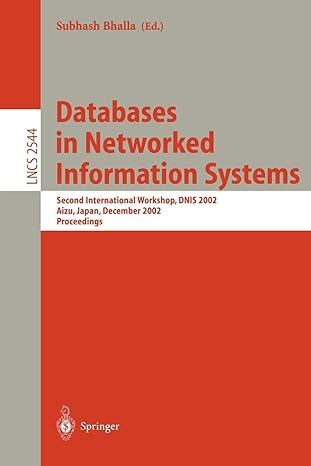Question
The project report will contain the following materials. 1. The cover page This includes the project title, the names of the group
The project report will contain the following materials.\ \ 1. The cover page \ \ This includes the project title, the names of the group members, the course name and title (CSC 330 Database Systems), Jackson State University, and the date.\ \ 2. Abstract\ \ This tells what the project is. It focuses on the project itself, i.e. the domain and the technologies used. Do not put too much background information.\ \ 3. Introduction\ \ Tell what this project is about. You may choose any project that has database content. This includes the domain this project is built for, the technologies you use to build this project, and other background information. This part is more detailed than the abstract and self-contained.\ \ 4. Requirements/Domain knowledge\ \ You choose a software domain. Describe what domain business processes (activities) the software you will build to model. Describe it in a few paragraphs or, a better way, follow object oriented analysis paradigm, which includes actors, use cases, scenarios for each use case, a class diagram, and a number of sequence diagrams for the most important activities.\ \ In this phase, extract nouns and noun phrases for classes (entities) and attributes and extract verbs and verb phrases for use cases and associations (relationships) from the description of the business processes (activities).\ \ A simpler way is to describe activities you want to model. Focus on verbs and verb phrases first. They will become relationships. Nouns and noun phrases will become entities. They support the relationships being identified. \ 5. Design\ Describe what entities and relationships are needed to support the business processes (domain activities) stated in requirements. \ \ Describe what business processes (domain activities) are needed to operate on the data sets (entities and data sets derived from relationships). \ \ Then draw an E-R diagram.\ \ 6. Translation to a relational model\ \ Translate the ER diagram into a relational model. The result is a collection of tables to represent the entities and relationships in the ER diagram. Mark all keys of the tables.\ \ 7. Functional dependencies, keys, and normalization\ \ Define a number of functional dependencies. Normalize the schemas (definitions for tables (relations)) if needed.\ \ 8. Creating the database\ \ Provide SQL statements for creating the tables in this relational model.\ Actually create the database schemas (tables) in a database management system (we will use MySQL). \ \ 9. Implementing the application\ \ This application models the business processes (domain activities). Operating on the database tables is the essential part of the application. Implement this application in Java with JDBC or C++ and MySQL. Usually students do not have time to finish the implementation. In this case, implementation is not required. \ \ 10. Conclusion\ \ Summarize your experience after having completed this project.\ \ 11. Future work\ \ Anything you can think of as an extension to this project or any related projects you may be interested. \ \ 12. References\ \ All the documents, papers, books cited in the report are listed here.\ \ 13. Appendices\ Place your source code and other materials, if any, here.
Step by Step Solution
There are 3 Steps involved in it
Step: 1

Get Instant Access to Expert-Tailored Solutions
See step-by-step solutions with expert insights and AI powered tools for academic success
Step: 2

Step: 3

Ace Your Homework with AI
Get the answers you need in no time with our AI-driven, step-by-step assistance
Get Started


